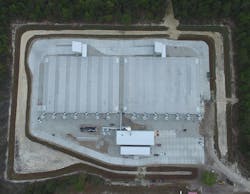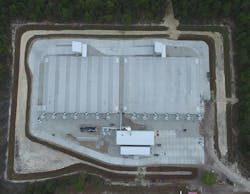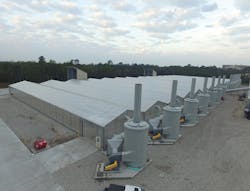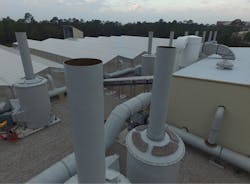Biosolids Facility Revolutionizes Drying Process for Florida Utility
Composite ductwork is a key component for extreme conditions
In the wastewater industry, one of the most cost-effective options for dealing with municipal biosolids and sewage sludge is to send it to a landfill. But as space becomes limited, fewer and fewer landfills are willing to take on raw sludge and treated biosolids. That’s a problem for Pasco County, Fla., which spends about $1.3 million per year on sludge disposal.
However, a new biosolids drying facility slated to open this summer could present a groundbreaking solution saving the county up to $450,000 annually. Biosolids management company Merrell Bros Inc. anticipates that it could turn approximately 50,000 tons of wastewater sludge per year into household fertilizer.
A bird’s eye view of the facility, two times larger than any similar facility in North America.
The facility, which is twice as large as any other similar facility in North America, houses two units that Merrell Bros. refers to as “pods,” consisting of seven 216-x-42-foot interconnected greenhouses. Inside the pods, the biosolids are pre-dried and pasteurized through a newly patented process that uses solar energy to bring them from 80 percent moist to 60 percent dry and 40 percent moist. The greenhouse units are then covered with a clear LEXAN™ polycarbonate sheet, which allows a maximum amount of sunlight to enter the greenhouses.
In addition to providing sunlight, the pods are also responsible for keeping the air moving inside the greenhouses to encourage evaporation. Once the biosolids are finished pre-drying in the greenhouses, they are moved to belt dryers inside a separate processing building to fully dry and pasteurize. In order to comply with EPA regulations for pasteurization, the biosolids must be heated to 70˚C (158˚F) for a minimum of 30 minutes.
As Merrell Bros. was developing its process, it realized there were a number of issues to address. Specifically, the company had to figure out how to get each greenhouse and drying belt to filter massive volumes of air while still achieving an optimal humidity level and minimizing odor from the biosolids, which consist of primarily organic reduced sulfur compounds.
“We needed an air handling technology that would enhance the drying process, creating the best environment for the biosolids,” explained Ted Merrell, vice president and co-owner of Merrell Bros. “Figuring that out can be challenging, as you need something that can get the temperature just right. At the same time, we needed the best possible odor control since biosolids are chemically unstable.”
Typically, a conventional biofilter would be the optimal technology for this application. However, according to Jeff Jones, president of ECS Environmental Solutions, in the case of the Pasco County facility, implementing a traditional biofilter would likely be too cumbersome as the massive 460,000 cubic feet per minute (cfm) of airflow would require an extremely large footprint. Another complication is that no technology creates an absolute odor-free airstream, so a ground-level emission source would still adversely affect the fence-line odor threshold set forth in the facility design.
Instead, Merrell Bros. used 16 of ECS’s patented VX radial flow adsorber units to enhance the drying process and mitigate the odor. Each activated carbon VX unit in the facility takes in 28,500 cfm and is only 12 feet in diameter. The units disperse the air 40 feet high and at a rate of 3,000 feet per minute, reducing the facility’s fence-line impact. While the total odor removal rate of the activated carbon may be less than a biofilter, the combination of dispersion technology will help achieve the ultimate goal.
“We may have one set of parameters for odor control, but we also have to have moisture capacity,” said Merrell. “We needed to have 200,000 cfm of air exchanges in each of the greenhouse units to handle moisture processes. We put seven of those on each greenhouse pod — designed to draw 28,500 cfm of air each. We’re exchanging the air every five minutes, and an additional 60,000 cfm is being treated from the process building for a total airflow rate of approximately 460,000 cfm.”
To this end, special impaction filters were supplied by ECS to help remove moisture from the air before it enters the activated carbon.
The greenhouses and attached VX radial flow adsorber units.
On the odor control side, Merrell collaborated with Jones on what he calls “odor modeling,” which entailed collecting air samples from a pilot unit built by Merrell Bros.
“We created a mock greenhouse design and got concentration data from it,” said Merrell. “We then used ECS’s data and plugged it into dispersion modeling.” The results help balance treatment objectives and a dispersion target.
In addition to their air moisture capacity and ability to control odors, what really made the VX units attractive to Merrell Bros. was their construction using fiber reinforced polymer (FRP) composite materials designed to handle the toughest conditions. According to Jones, not only are composites the most cost-effective option but other materials, such as stainless steel, are not suitable for the service conditions.
“When treating odor from a municipal waste process, sulfuric acid can be generated in equipment treating the air, so you need a material that can handle extreme conditions and resist corrosion,” explained Jones.
This installation features filament-wound ductwork, vessels, stacks and special composite impaction moisture filters manufactured in ECS’s Belton, Texas, facility. Each 28,500-cfm exhaust fan is also constructed using the hand lay-up method supplied by the New York Blower Company. All components were professionally engineered to withstand hurricane-force winds.
According to the American Composites Manufacturers Association (ACMA), composite ductwork can provide decades’ worth of durability, a high strength-to-weight ratio, high performance in elevated temperatures and dimensional stability.
A close-up of VX radial flow adsorber units constructed with fiber reinforced polymer (FRP) composite materials.
“The Merrell Bros. facility is an excellent example of how FRP composites can help defeat the elements. We’re excited to see how the ECS units perform,” noted Thom Johnson, business manager of specialty resins at Ashland LLC and the chairman of ACMA’s Corrosion Control Division. “Composites have a long track record of proven performance in corrosive applications, but this is a potentially revolutionary application of our industry’s materials.”
Jones added that in his specific VX units, the unique ability to engineer the corrosion-resistant components extends the working life and reduces maintenance requirements. All of these benefits, he said, translate to lower capital costs and reduced operating costs.
In May, Merrell Bros. hosted an open house and began performance testing procedures as the processing buildings were built and the greenhouses were 98 percent complete at the time. The Class AA biosolid is already registered and classified as a commercial fertilizer under Chapter 576 of the Florida Statutes (FS) and will be marketed under the name “FloridaGreen.” Once in production, Merrell Bros. will market the fertilizer all over Florida.
Circle No. 241 on Reader Service Card



